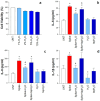Thermal Water Reduces the Inflammatory Process Induced by the SARS-CoV-2 Spike Protein in Human Airway Epithelial Cells In Vitro
- PMID: 39767823
- PMCID: PMC11672968
- DOI: 10.3390/biomedicines12122917
Thermal Water Reduces the Inflammatory Process Induced by the SARS-CoV-2 Spike Protein in Human Airway Epithelial Cells In Vitro
Abstract
Background: Although treatments using thermal water have yielded beneficial effects in respiratory tract infections, the effects of thermal water under experimental conditions similar to those triggered by SARS-CoV-2 have yet to be evaluated. This study aimed to assess whether thermal water could interfere with the interaction between SARS-CoV-2 and host cells and influence inflammatory factors. Methods: Human nasal epithelial primary cells (HNEpCs) were stimulated with SARS-CoV-2 spike protein in the presence or absence of thermal water or tap water. Cell viability, cytokine concentration, ACE2 and TMPRSS2 levels, and ACE2 activity were determined in the cell cultures. Results: Exposure of HNEpCs to spike protein increased IL-6, IL-8, and IL-1β production, with decreased production observed in the presence of thermal water at an optimal dose. Treatment of cells with tap water did not affect cytokine release in unstimulated or spike-stimulated cells. Spike-protein-stimulated HNEpCs showed reduced levels of ACE2, which were partially restored only in the presence of thermal water. Spike protein did not affect the TMPRSS2 levels of the cell lysates. Stimulation with spike protein induced an increase in the concentration of both receptors in the supernatants, while treatment with thermal water reduced TMPRSS2 levels in both the cells and supernatants. Stimulation with spike protein increased ACE2 activity, which was reduced with thermal water. Conclusions: This study shows the regulatory effects of mineral-rich thermal water on spike-protein-induced pro-inflammatory cytokine production and the amount and activity of receptors mainly involved in viral entry, suggesting a potential use of this treatment as a support therapy for SARS-CoV-2 infection of the upper respiratory tract.
Keywords: COVID-19; SARS-CoV-2; balneotherapy; inflammation; spike protein; thermal water.
Conflict of interest statement
The authors declare no conflicts of interest. The “Pietro d’Abano Thermal Studies Center” is a Non-Profit Institution.
Figures



Similar articles
-
Fullerenol C60(OH)40 Nanoparticles and Ectoine Protect Human Nasal Epithelial Cells Against the Cytokine Storm After Addition of the Full-Length Spike Protein from SARS-CoV-2.Int J Nanomedicine. 2024 Nov 21;19:12221-12255. doi: 10.2147/IJN.S482652. eCollection 2024. Int J Nanomedicine. 2024. PMID: 39600409 Free PMC article.
-
SARS-CoV-2 Induces Expression of Cytokine and MUC5AC/5B in Human Nasal Epithelial Cell through ACE 2 Receptor.Biomed Res Int. 2022 Jun 2;2022:2743046. doi: 10.1155/2022/2743046. eCollection 2022. Biomed Res Int. 2022. PMID: 35692597 Free PMC article.
-
Regulation of Proinflammatory Molecules and Tissue Factor by SARS-CoV-2 Spike Protein in Human Placental Cells: Implications for SARS-CoV-2 Pathogenesis in Pregnant Women.Front Immunol. 2022 Apr 7;13:876555. doi: 10.3389/fimmu.2022.876555. eCollection 2022. Front Immunol. 2022. PMID: 35464466 Free PMC article.
-
Therapeutic potential of green tea catechin, (-)-epigallocatechin-3-O-gallate (EGCG) in SARS-CoV-2 infection: Major interactions with host/virus proteases.Phytomed Plus. 2023 Feb;3(1):100402. doi: 10.1016/j.phyplu.2022.100402. Epub 2022 Dec 30. Phytomed Plus. 2023. PMID: 36597465 Free PMC article. Review.
-
Contributions of human ACE2 and TMPRSS2 in determining host-pathogen interaction of COVID-19.J Genet. 2021;100(1):12. doi: 10.1007/s12041-021-01262-w. J Genet. 2021. PMID: 33707363 Free PMC article. Review.
References
-
- Maccarone M.C., Magro G., Albertin C., Barbetta G., Barone S., Castaldelli C., Manica P., Marcoli S., Mediati M., Minuto D., et al. Short-time effects of spa rehabilitation on pain, mood and quality of life among patients with degenerative or post-surgery musculoskeletal disorders. Int. J. Biometeorol. 2023;67:29–36. doi: 10.1007/s00484-022-02381-4. - DOI - PMC - PubMed
-
- Cacciapuoti S., Luciano M.A., Megna M., Annunziata M.C., Napolitano M., Patruno C., Scala E., Colicchio R., Pagliuca C., Salvatore P., et al. The role of thermal water in chronic skin diseases management: A review of the literature. J. Clin. Med. 2020;9:3047. doi: 10.3390/jcm9093047. - DOI - PMC - PubMed
Grants and funding
LinkOut - more resources
Full Text Sources
Miscellaneous

